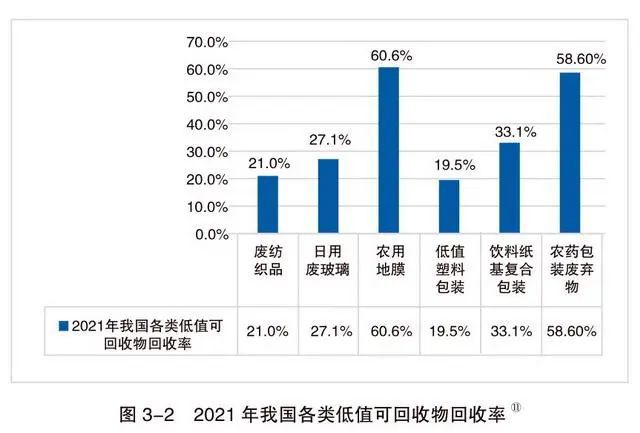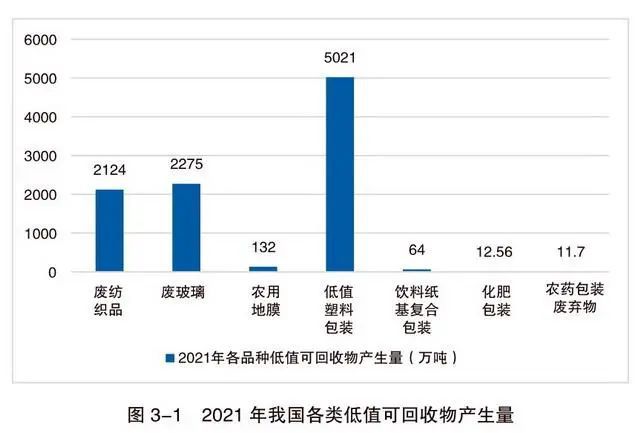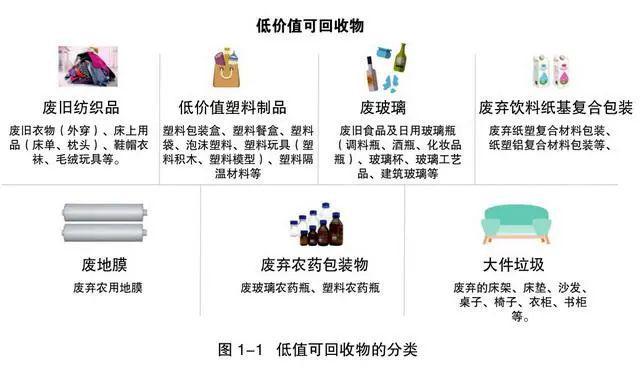2024.01.09
The recovery rate of low-value recyclables is only 26.6%, and 70 million tons are in urgent need of high-value utilization
Page view:445
On January 8, the "Research Report on the Status Quo of China's low-value recyclables Recycling" released by the Institute of Economic System and Management of the Development and Reform Commission (hereinafter referred to as the report) shows that in 2021, in addition to large waste, the production volume of all types of low-value recyclables in China is about 95.77 million tons, the recycling volume is about 25.47 million tons, and the total recovery rate is about 26.6%. There are still about 70 million tons of domestic waste mixed into incineration or landfill, far below the average recycling rate of more than 75% of China's main renewable resources.
Primary data
According to the report, low-value recyclables are a concept opposite to high-value waste such as scrap cars and waste household appliances, which mainly refers to all kinds of waste generated in production and life with certain recycling value, which can realize material recycling and utilization through certain technical and economic means and obtain certain economic benefits. However, due to the poor economic benefits of recycling and utilization, low-value recyclables can be recycled and reused. It is difficult to achieve a high proportion of recycling by relying solely on the spontaneous behavior of business entities, such as waste glass, waste textiles, beverage paper-based composite packaging, low-value plastic packaging, fertilizer and pesticide packaging, mulch film, etc.
The report shows that in 2021, China produced a total of 50.21 million tons of waste low-value plastic packaging, 22.75 million tons of waste glass, 21.24 million tons of waste textiles, 1.32 million tons of agricultural mulching film, 640,000 tons of beverage paper based composite packaging, 125,600 tons of fertilizer packaging and 117,000 tons of pesticide packaging, and the overall production volume is large.

The production volume of all kinds of low-value recyclables in China in 2021. Source: Survey Report on Recycling Status of Low-value Recyclables in China
In 2021, the total amount of all kinds of low-value recyclables in China will be about 25.47 million tons, with a recovery rate of about 26.6%. Among them, the recovery rate of waste agricultural mulching film reached 60.6%, the recovery rate of pesticide packaging waste, beverage paper based composite packaging, daily waste glass, waste textiles, low-value plastic packaging was 58.6%, 33.1%, 27.1%, 21% and 19.5%, and the overall recycling rate was low.

The recovery rate of all kinds of low-value recyclables in China in 2021. Source: Survey Report on Recycling Status of Low-value Recyclables in China
Pesticide packaging waste
According to the survey report, the total production of pesticide packaging waste in 2021 will be about 134,000 tons, and about 126,500 tons in 2022. The amount of fertilizer packaging waste produced in 2022 will be 117,000 tons. Due to the pesticide packaging will contain certain pesticide residues, mixed with other waste plastics recycling there is a certain safety hazard, at present, China's pesticide packaging is basically incineration or landfill treatment, a small amount of fertilizer packaging will be used after cleaning for farmers to hold items or collection for recycling.
The investigation found that the harmless disposal capacity of pesticide packaging waste in China is relatively insufficient, the disposal price is high, and it is difficult to effectively dispose of pesticide packaging waste in a timely manner after collection, which affects the enthusiasm of front-end recycling. The pressure of grass-roots recycling outlets is greater, and the conditions of recycling and temporary storage warehouses in individual areas are simple, which is easy to have security risks. In addition, the long-term recovery and treatment mechanism is not perfect, the deposit recovery system of fertilizer and pesticide packaging has not been generally established, and the enthusiasm of farmers to participate in recycling is not high.
Low value plastic packaging
Low-value plastic packaging covers all aspects of production and life, mainly in the form of commodity packaging or daily plastic shopping bags, garbage bags, express packaging. It is estimated that in 2022, the use of low-value plastic packaging in China will be 50.66 million tons, and the recycling amount will be 8.25 million tons, with a recovery rate of 16.3%, most of which will be incinerated or disposed of in landfills along with domestic waste.
The survey found that the recycling of low-value plastic packaging is faced with a triple dilemma from the design, recycling links and different processing paths: recyclability is not fully considered in the design and production process, most of the composite material design, which is technically difficult to recycle, and can only be incinerated or landfill treatment after one-time use; The recycling link has not yet been opened, low-value plastic packaging is basically classified as "other waste", and few cities recycle it separately; Low-value plastic packaging is difficult to carry out effective sorting and large-scale collection in the domestic waste disposal system.
The recycling of beverage paper based composite packaging has high technical requirements, difficult to cover the cost, and the demand for back-end regeneration is not strong; Agricultural mulch recovery rate is high but difficult to use, there are many manufacturers of agricultural film, quality is uneven, ultra-thin and other unqualified mulch still exist in large numbers, aggravating the recycling problem.
Relevant policies are urgently needed
According to the "Investigation report", at present, there are no laws, regulations and policy documents specifically for the recycling of low-value recyclables, and only relevant principled provisions are scattered in other laws and regulations or planning documents.
The Circular Economy Promotion Law promulgated in 2009 stipulates the recycling and utilization of renewable resources, including some low-value recyclables; According to the Environmental Protection Law revised in 2015, agricultural producers and operators should scientifically dispose of agricultural waste such as agricultural film. The "Law on the Prevention and Control of Environmental Pollution by Solid Waste" revised and implemented in 2020 clearly stipulates specific provisions on plastic pollution, and proposes to promote the application of alternative products that can be recycled, easily recycled and degradable; The recycling and utilization of waste such as agricultural film and pesticide packaging should be strengthened.
The 14th Five-Year Plan for the Development of circular Economy proposes to build a recycling system for waste materials, implement standardized management of the recycling and utilization of renewable resources such as waste plastics and paper, and improve the standardization level of the industry. In 2022, the "Guiding Opinions on Accelerating the Construction of the Recycling System of Waste Materials" of the National Development and Reform Commission and other departments clearly proposed to encourage conditional local governments to formulate support policies on the recycling and utilization of low value-added recyclables.

Classification of low value recyclables. Source: Survey Report on Recycling Status of Low-value Recyclables in China
At present, some cities have issued local guidance documents, such as the "Shanghai Recyclables Guidance Catalogue (2019 edition)" issued by the Shanghai Greening and City Appearance Administration; Guangzhou issued the "Management Measures for the purchase of low-value recyclable recycling treatment services" and so on. Due to the large difference between the level of urban economic development and resource utilization, the scope of low-value recyclables is also different.
The survey found that the subsidy standard for recycling of low-value recyclables also varied from place to place. For example, Quanzhou City, Fujian Province, "Low value recyclables classification collection, transportation and treatment of funding subsidies (trial)" stipulates that the collection and transportation enterprises to classify the low-value recyclables of the domestic waste classification pilot to subsidize. Low value recyclables are subsidized at 186 yuan per ton.
The "Implementation Rules for Low value-added recyclables Recycling and Treatment Subsidies" of Minhang District of Shanghai stipulates that in 2020, the main enterprises responsible for the operation of the two networks integration distribution field at the district level and the main enterprises responsible for the operation of the two networks integration transfer station in each street town (Xinzhuang Industrial Zone) will implement the operation and disposal cost subsidies, the standard is not more than 111.5 yuan/ton (ultimately subject to the winning price); Hangzhou Fuyang District's "Implementation Opinions on Renewable Resource Recycling Subsidies in 2021 (Trial)" stipulates that low-value recyclables in 2021 will be subsidized according to the 300 yuan/ton standard.
According to the "Survey report", at present, China's garbage classification and recycling system at the recycling end is not perfect, and the classification effect of low-value recyclables at the source is poor; At the disposal end of the city, the centralized sorting facilities are not perfect, not supporting, and the centralized sorting capacity is insufficient. At the utilization end, the enterprise participation enthusiasm is not high, and the utilization technology level is low. Small and scattered enterprises are the main problems facing the industry.
Previous:Research progress of waste pla...
Next:Unilever adjusts its strategy ...

